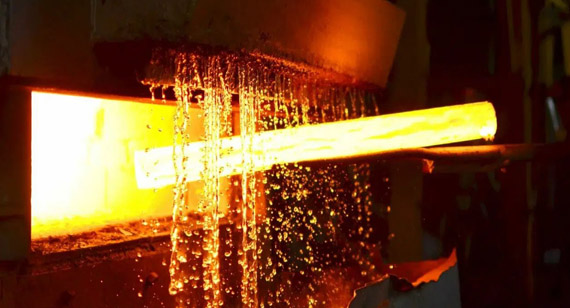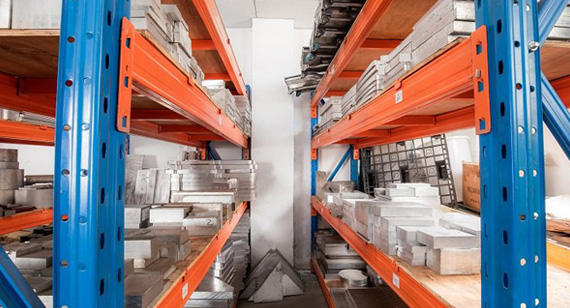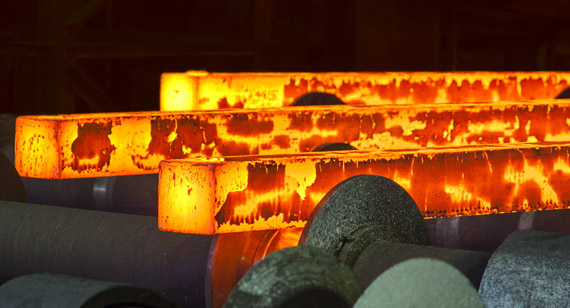15 years one-stop China custom CNC machining parts factory
 379 |
Published by VMT at Aug 11 2024
379 |
Published by VMT at Aug 11 2024
Heat treatment of metals is an indispensable part of metal processing. It involves a series of techniques, including heating, holding, and cooling, to alter the internal structure of metallic materials and adjust their physical, chemical, and mechanical properties. This process not only enhances material strength, hardness, and toughness but also improves special properties like corrosion resistance, wear resistance, and heat resistance, providing a solid foundation for high-quality manufacturing of CNC-machined parts. Heat treatment technology is widely used in aerospace, automotive manufacturing, mechanical engineering, energy, chemical processing, and many other fields, making it a critical pillar of modern industrial development.

The basic process of heat treatment includes three stages: heating, holding, and cooling. First, the metal workpiece is placed in a furnace and heated using methods such as electric heating, gas heating, or induction heating to a predetermined temperature. This allows the atoms or molecules within the metal to gain enough energy to alter their arrangement. In the holding stage, the workpiece is maintained at a set temperature for a specific period to ensure that the heat penetrates the workpiece evenly, resulting in a uniform structural transformation. Finally, in the cooling stage, the workpiece is cooled using various methods (such as water quenching, oil quenching, air cooling, etc.), controlling the cooling rate to achieve the desired material properties.
Hardening
The goal of hardening is to increase the hardness and strength of the metal by rapidly cooling it (quenching) to form a martensitic structure. This process requires precise control of heating temperatures and cooling rates to avoid excessive internal stress and cracking.
Annealing
Annealing is a heat treatment method that involves slow cooling to eliminate internal stress and structural defects in the metal, while reducing hardness and increasing toughness. Depending on the objective, annealing can be divided into various types, including full annealing, spheroidizing annealing, and recrystallization annealing.
Tempering
Tempering is the process of reheating the metal to a temperature below the critical point after quenching, holding it for a period, and then cooling it. This is primarily used to adjust the hardness and toughness of quenched steel, relieve internal stress, and improve the stability and service life of the workpiece.
Surface Hardening
Surface hardening is a method that involves localized heating and rapid cooling, making only the surface of the metal hard while keeping the core tough and strong. Common surface hardening techniques include carburizing, nitriding, and high-frequency induction hardening.
Normalizing
Normalizing involves heating the metal to just above its critical temperature, holding it for a while, and then allowing it to cool in the air. This process is mainly used to refine the grain structure, improve structural uniformity, and eliminate network carbides, preparing the material for further processing.
Heat treatment is crucial in CNC-machined metal parts manufacturing. First, it significantly enhances the mechanical properties of materials, such as strength, hardness, and toughness, thereby improving the load-bearing capacity and service life of parts. Additionally, heat treatment can improve machinability, reduce cutting forces, and increase machining accuracy and surface quality. Furthermore, it allows the adjustment of physical and chemical properties like corrosion resistance, wear resistance, and heat resistance to meet various operational demands. Therefore, heat treatment is an essential step in the manufacturing process of CNC-machined metal parts.

Cast Iron, Carbon Steel, Martensitic Stainless Steel, Tool Steel, and Steel Alloys
These metals contain higher levels of carbon or other alloying elements, which allows their internal structure and properties to be significantly altered through heat treatment. For example, carbon steel can achieve a good combination of strength and toughness through quenching and tempering, while tool steel can increase its hardness and wear resistance to meet the demands of cutting applications.
Heat Treatment Methods:
Depending on the specific material and desired properties, appropriate heating temperatures, holding times, and cooling methods are used. For instance, carbon steel typically undergoes quenching and tempering, while martensitic stainless steel may require solution treatment to achieve a single-phase austenitic structure.
Aluminum
While aluminum's good thermal conductivity makes it difficult to achieve significant strength increases through conventional heat treatment, some aluminum alloys, such as duralumin and super-duralumin, can be strengthened through solution treatment and aging.
Heat Treatment Methods:
Solution treatment involves heating the aluminum alloy to a temperature where alloying elements dissolve completely into the matrix, followed by rapid cooling to lock in the high-temperature structure. Aging treatment follows, where the aluminum alloy is held at a lower temperature for some time, allowing the alloying elements to precipitate and create a strengthening effect.
Copper and Copper Alloys
Heat treatment for copper and its alloys is less common due to copper's excellent thermal conductivity, which makes it difficult to significantly alter its properties through heat treatment. However, certain copper alloys, such as brass and bronze, can undergo annealing to relieve internal stress and improve machinability.
Heat Treatment Methods:
Annealing typically involves lower heating temperatures and longer holding times to avoid grain coarsening.
Titanium
Titanium alloys possess excellent mechanical properties, corrosion resistance, and high-temperature performance, making them essential materials in aerospace applications. The heat treatment of titanium alloys primarily includes annealing, solution treatment, and aging.
Heat Treatment Methods:
Annealing is used to relieve internal stress and eliminate structural defects in titanium alloys during processing. Solution treatment involves heating to dissolve alloying elements fully into the matrix, followed by rapid cooling to lock in the high-temperature structure. Aging then allows for subsequent holding to precipitate the alloying elements, resulting in a strengthening effect.
Nickel Alloys
Nickel alloys are widely used in chemical, petroleum, and aerospace industries due to their excellent corrosion resistance and high-temperature strength. The heat treatment of nickel alloys is also crucial, including solution treatment, aging, and annealing. Solution treatment aims to dissolve alloying elements evenly within the matrix to form a single-phase solid solution, enhancing corrosion resistance. Aging treatment controls the cooling rate and subsequent holding to precipitate the alloying elements in a specific manner, strengthening the alloy. Annealing helps to relieve internal stress and eliminate structural defects from the manufacturing process, improving the alloy's machinability.
Heating Stage
The heating stage is the first and most critical step in heat treatment. During this stage, the metal workpiece is placed in a furnace and heated to a predetermined temperature using methods such as electric heating, gas heating, or induction heating. It is essential to strictly control the heating rate and temperature uniformity to prevent deformation or cracking caused by localized overheating.
Soaking Stage
The soaking stage, also known as the holding stage, is where the metal workpiece is maintained at the desired temperature for a specific period. The primary purpose of this stage is to allow heat to penetrate the workpiece fully, ensuring a uniform transformation of the internal structure. The duration of the holding time depends on factors such as the type of metal, workpiece size, and desired properties.
Cooling Stage
The cooling stage is the final step in heat treatment and is crucial in determining the final material properties. During this stage, the metal workpiece is cooled using various methods (such as water quenching, oil quenching, air cooling, etc.), either rapidly or slowly. The choice of cooling rate depends on the desired material properties. Rapid cooling (such as quenching) can produce a high-hardness and high-strength martensitic structure, while slow cooling (such as annealing) helps eliminate internal stress and structural defects, improving toughness and machinability.

Heat Treatment Time
The duration of heat treatment directly affects the degree and uniformity of structural transformation within the metal. Insufficient time may lead to incomplete structural changes, while excessive time can cause grain growth or other undesired structures.
Heating Temperature
The heating temperature is one of the core parameters in heat treatment processes. It determines the activity level of atoms or molecules within the metal and the likelihood of structural transformation. Excessive temperature may cause metal melting or overheating, while insufficient temperature may fail to achieve the desired structural transformation.
Degree of Deformation
Metal workpieces may undergo deformation due to thermal stress during heating and cooling in heat treatment. The degree of deformation not only affects the dimensional accuracy and shape stability of the workpiece but may also negatively impact the material's properties. Therefore, appropriate measures should be taken during heat treatment to control and minimize deformation.
Microstructure Transformation
Microstructure transformation refers to the changes in the internal structure of the metal during heat treatment. Good microstructure transformation means the metal has a uniform, dense structure that meets performance requirements, while poor transformation can lead to reduced material performance or defects.
Type of Metal
Different metals have different chemical compositions and structural characteristics, so their heat treatment processes vary. For example, the heat treatment processes for carbon steel and stainless steel differ, and aluminum alloys and titanium alloys have more complex and diverse heat treatment requirements.
Cooling Rate
Cooling rate is one of the key factors influencing the properties of metals after heat treatment. Rapid cooling can produce high-hardness and high-strength structures, while slow cooling helps eliminate internal stress and structural defects. Therefore, selecting the appropriate cooling method based on the desired material properties is crucial.
Furnace Atmosphere
The atmosphere inside the heat treatment furnace also affects the heat treatment process. For example, an oxidizing atmosphere can cause surface oxidation and scale formation on metal workpieces, while a reducing atmosphere can prevent oxidation and reduce the formation of undesired compounds.
Workpiece Size
The size and shape of the metal workpiece also influence the heat treatment process. Larger or more complexly shaped workpieces may require longer heating times or different cooling methods to achieve uniform structural transformation.
Hardening
Hardening of steel is primarily achieved through quenching. Quenching is a process where steel is heated above the austenitizing temperature, held for a certain time, and then rapidly cooled. This process forms a high-hardness martensitic structure within the steel, thereby increasing its hardness and strength.
Tempering
Tempering is the process of reheating quenched steel to a specific temperature, holding it for a period, and then cooling it. The main purpose of tempering is to reduce the brittleness of quenched steel and improve its toughness. Additionally, by adjusting the tempering temperature and time, different combinations of hardness and strength can be achieved to meet various application requirements.
Annealing
Annealing is a heat treatment process that involves heating and slow cooling to eliminate internal stresses and structural defects within the steel. Annealing can refine the grain structure, improve the microstructure, reduce hardness, and increase toughness. It also prepares the material for subsequent processing, such as cutting or forging. Types of annealing include full annealing, spheroidizing annealing, and recrystallization annealing.
The annealing process consists of three main steps: heating to a predetermined temperature, holding to ensure thorough transformation of the structure, and slow cooling to room temperature. Each step is crucial and collectively determines the effectiveness of the annealing process. During the heating phase, it's essential to ensure uniform temperature across the steel to promote even internal structural transformation. The holding phase allows sufficient time for structural changes, such as spheroidization of carbides or stress relief. The slow cooling phase prevents the development of internal stresses and structural defects that can occur due to rapid cooling.
Normalizing
Normalizing is a heat treatment process in which steel is heated to a temperature 30-50°C above the Ac3 (critical temperature) or Accm (complete austenitizing temperature), held for a period, and then cooled in air. The primary purpose of normalizing is to refine the grain structure, improve the microstructure, and enhance the mechanical properties and machinability of the steel. Compared to annealing, normalizing has a faster cooling rate, resulting in a finer structure with higher strength and hardness.
Key Points in Normalizing Steel:
Improved Mechanical Properties
Heat treatment can significantly enhance the mechanical properties of metals, such as strength, hardness, and toughness, making the material more suitable for complex working environments and load conditions.
Increased Wear Resistance
Techniques like surface hardening can greatly increase the hardness and wear resistance of metal surfaces, extending the service life of components.
Enhanced Machinability
Processes like annealing and normalizing can improve the machinability of metals, reduce cutting forces, and increase machining precision, facilitating subsequent mechanical processing.
Stress Relief
Heat treatment can relieve residual stresses within the metal caused by processes such as machining or welding, improving dimensional stability and operational safety of the parts.
Improved Electrical and Magnetic Properties
Heat treatment can also enhance the electrical and magnetic properties of metals, such as increasing resistivity and reducing hysteresis loss, to meet specific application needs.
Enhanced Heat and Corrosion Resistance
Appropriate heat treatment processes can increase the stability of metals in high-temperature environments and improve their corrosion resistance, extending the service life of components.
Improved Dimensional Stability
Heat treatment can eliminate dimensional changes within metals caused by temperature fluctuations, enhancing the dimensional stability and precision of parts.
Metal heat treatment plays a crucial role in metal processing, significantly improving material performance, extending component service life, and meeting the demands of complex working conditions. By carefully selecting heat treatment parameters and strictly controlling the process, the full potential of metal materials can be realized, providing strong support for the high-quality manufacturing of CNC-machined parts. As technology continues to advance and processes are refined, metal heat treatment technology will see wider application and promotion across various fields.
As a professional CNC machining factory, VMT possesses extensive experience in metal heat treatment processes and advanced equipment. We are dedicated to providing customized CNC machining services and CNC prototype machining solutions, ensuring that every metal component achieves optimal performance. In terms of heat treatment, we have a professional technical team and comprehensive testing methods to develop suitable heat treatment process plans based on customer needs and material characteristics. Through precise control and strict quality inspection, we ensure consistency and stability in heat treatment results. Additionally, we focus on technological innovation and process optimization, continuously introducing new technologies and equipment to enhance our heat treatment process capabilities and product quality.
What is the difference between heat treatment and annealing?
Heat treatment is a broad term that includes various processes such as annealing, quenching, tempering, and more. Annealing is just one type of heat treatment, mainly used to eliminate internal stresses and structural defects, improving toughness and machinability.
How is heat used to strengthen metals?
Metals can be strengthened through heat treatment processes like quenching, which involves rapid cooling to form a high-hardness martensitic structure within the metal. Surface hardening treatments such as carburizing or nitriding can also increase surface hardness and wear resistance.
Can all metals undergo heat treatment?
Not all metals can undergo effective heat treatment. Only metals whose internal structure can be significantly altered through heating and cooling can benefit from heat treatment. For example, pure iron, carbon steel, and alloy steel can have their properties significantly changed through heat treatment, whereas metals like pure aluminum are more stable and less affected by heat treatment.
What is the difference between annealing and normalizing?
Both annealing and normalizing involve heating and cooling processes, but they serve different purposes and produce different results. Annealing primarily aims to relieve internal stresses and structural defects, improving toughness and machinability, whereas normalizing is intended to refine grain structure, improve microstructure, and enhance strength and hardness. Additionally, they differ in heating temperature and cooling rate.
Can stainless steel be heat treated?
Yes, stainless steel can be heat treated, but the specific heat treatment process depends on the type of stainless steel and the desired properties. For instance, austenitic stainless steel typically does not require quenching because it cannot form a high-hardness martensitic structure through quenching. However, martensitic stainless steel can be hardened and strengthened through quenching and tempering.
What is the heat treatment temperature for steel?
The heat treatment temperature for steel depends on the specific process and the type of steel. For example, quenching requires heating the steel above the austenitizing temperature and holding it for a period. Annealing, on the other hand, requires heating to a temperature slightly below the melting point but high enough to relieve stress and improve structure, with holding for a specific time. Typically, quenching temperatures are above the critical temperature (Ac1 or Ac3) of the steel, with the exact value depending on the chemical composition and desired properties. Annealing temperatures are lower, usually below the austenitizing temperature, depending on the type of annealing (such as full annealing, spheroidizing annealing) and the characteristics of the steel.
How do heating and cooling rates affect steel during heat treatment?
Heating rate affects steel in two main ways: first, it impacts the uniformity of structural transformation, as rapid heating can cause large internal-external temperature differences, leading to uneven structural changes; second, it affects the material's properties. Particularly for certain steel types, a rapid heating rate can cause grain growth or other undesirable structures. Cooling rate is equally important as it determines the final structure and properties of the steel. Rapid cooling (e.g., quenching) can form a high-hardness martensitic structure, increasing strength and hardness but also potentially increasing brittleness. Slow cooling (e.g., annealing) helps to relieve internal stresses and structural defects, improving toughness and machinability.
How do you choose the right heat treatment process?
Choosing the right heat treatment process involves considering various factors, including the type of steel, chemical composition, initial structure, desired performance requirements, and conditions for subsequent processing or use. Generally, the first step is to identify the purpose of the heat treatment, whether it's to enhance strength, improve toughness, relieve stress, or other goals. Then, based on the characteristics and performance requirements of the steel, select the appropriate heat treatment process and parameters. During the selection process, reference relevant standards, manuals, or consult professional technicians. Finally, validate the chosen process through testing, and make necessary adjustments and optimizations based on actual results.
